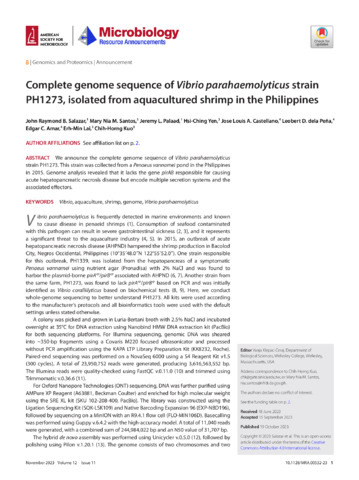Perlihatkan publikasi sederhana
Vibrio load and percentage composition of sucrose‐fermenting vibrios in Nile tilapia (Oreochromis niloticus) cultured in brackish water earthen ponds and biocontrol potential of recycled tilapia‐conditioned greenwater against population growth of V. parahaemolyticus and non‐sucrose‐fermenting vibrios in the grow‐out culture of white leg shrimp (Litopenaeus vannamei)
| dc.contributor.author | Pakingking, Rolando V., Jr. | |
| dc.contributor.author | Palma, Peter | |
| dc.contributor.author | de Jesus-Ayson, Evelyn Grace T. | |
| dc.contributor.author | Usero, Roselyn | |
| dc.date.accessioned | 2022-10-24T06:15:04Z | |
| dc.date.available | 2022-10-24T06:15:04Z | |
| dc.date.issued | 2022-10-20 | |
| dc.identifier.citation | Pakingking, Jr., R., Palma, P., de Jesus‐Ayson, E. G., & Usero, R. (2022). Vibrio load and percentage composition of sucrose‐fermenting vibrios in Nile tilapia (Oreochromis niloticus) cultured in brackish water earthen ponds and biocontrol potential of recycled tilapia‐conditioned greenwater against population growth of V. parahaemolyticus and non‐sucrose‐fermenting vibrios in the grow‐out culture of white leg shrimp (Litopenaeus vannamei). Aquaculture Research, are.16148. https://doi.org/10.1111/are.16148 | en |
| dc.identifier.issn | 1355-557X | |
| dc.identifier.uri | http://hdl.handle.net/10862/6394 | |
| dc.description.abstract | Vibrio are known opportunistic pathogens of pond-cultured fish and shrimp. This study determined the presumptive Vibrio count (PVC) and percentage composition of “beneficial” sucrose-fermenting vibrios (SFVs) and “pathogenic” non-SFVs in the water, sediment, gills and intestines of healthy tilapia Oreochromis niloticus collected every 2 weeks from Days 30 to 120 post-stocking in brackish water earthen ponds. PVCs in water and sediment ranged from 102–104 CFU/ml/CFU/g while in tilapias' gills and intestines, PVCs ranged from 103–106 CFU/g and 102–106 CFU/g, respectively, with SFVs dominating in water, sediment, gills (≥50%), and intestines (≥80%) of tilapia. Because use of tilapia-conditioned green water (TCGW) for shrimp's grow-out culture has been reported effective against acute hepatopancreatic necrosis disease outbreaks caused by V. parahaemolyticus, PVC, SFVs/non-SFVs (%), and V. parahaemolyticus count (VPC) in the recycled TCGW and Litopenaeus vannamei's hepatopancreas were also examined from stocking until 105 days of culture (DOC) in earthen ponds. PVCs ranging from 102–103 CFU/ml and 103–104 CFU/g were noted in water and shrimp's hepatopancreas, respectively. While non-SFVs population in water varied, a downward trend typified by an abrupt 50% reduction was noted in hepatopancreas at DOC 42, and remained or further dropped until DOC 105. VPCs in water likewise varied (undetectable–102 CFU/ml) while in hepatopancreas, counts dropped to undetectable level from DOC 70 onwards. Current data illustrate that remarkable shift of SFVs' dominance in the water and concomitantly in shrimp's hepatopancreas, plays a pivotal role in regulating non-SFVs proliferation in shrimp's hepatopancreas via competitive exclusion. | en |
| dc.description.sponsorship | This study was funded by SEAFDEC AQD (study code: FH02-F2013-T) and in part by the Department of Science and Technology-National Research Council of the Philippines (DOST-NRCP) (NRCP Project No. E-225). | en |
| dc.language.iso | en | en |
| dc.publisher | Wiley | en |
| dc.subject | Vibrio | en |
| dc.subject | tilapia | en |
| dc.subject | Oreochromis niloticus | en |
| dc.subject | Vibrio parahaemolyticus | en |
| dc.subject | Penaeus vannamei | |
| dc.title | Vibrio load and percentage composition of sucrose‐fermenting vibrios in Nile tilapia (Oreochromis niloticus) cultured in brackish water earthen ponds and biocontrol potential of recycled tilapia‐conditioned greenwater against population growth of V. parahaemolyticus and non‐sucrose‐fermenting vibrios in the grow‐out culture of white leg shrimp (Litopenaeus vannamei) | en |
| dc.type | Article | en |
| dc.identifier.doi | 10.1111/are.16148 | |
| dc.citation.spage | are.16148 | |
| dc.citation.journalTitle | Aquaculture Research | en |
| dc.subject.asfa | tilapia culture | en |
| dc.subject.asfa | vibriosis | en |
| dc.subject.asfa | nursery ponds | en |
| dc.subject.asfa | kinetics | en |
| dc.subject.asfa | shrimp culture | en |
| dc.subject.asfa | biological control | en |
| dc.subject.asfa | growing ponds | en |
| dc.subject.asfa | pond culture | en |
| dc.identifier.essn | 1365-2109 | |
| dc.subject.scientificName | Vibrio | en |
| dc.subject.scientificName | Vibrio parahaemolyticus | en |
| dc.subject.scientificName | Litopenaeus vannamei | en |
| dc.subject.scientificName | Penaeus vannamei | |
| local.subject | chromogenic agar | en |
| local.subject | hepatopancreas | en |
| local.subject | intestine | en |
| local.subject | sucrose-fermenter | en |
| local.subject | threshold level | en |
| local.subject | VPAHPND | en |
Files in this item
| Files | Size | Format | View |
|---|---|---|---|
|
There are no files associated with this item. |
|||
Publikasi ini ada di koleksi berikut
-
Journal Articles [1256]
These papers were contributed by Department staff to various national and international journals.




